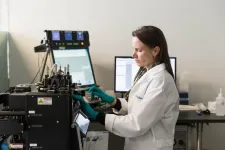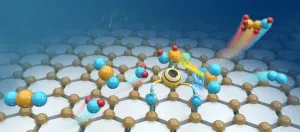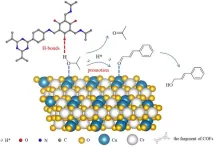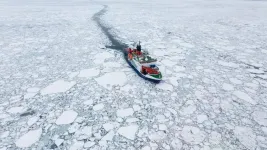(Press-News.org) Microplastics, from the beads that were once commonplace in cosmetics to the weathered and broken-down remnants of trash, are now ubiquitous in marine and inland waters around the world. To date, though, scientists have struggled to identify which plastics persist longest in the environment and measure their abundance, especially at the smaller end of the size range where they’re most likely to be consumed by foundational species near the bottom of the food web, like zooplankton.
Researchers from Bigelow Laboratory for Ocean Sciences and the University of Minnesota Duluth have now developed an innovative analytical method that combines different specialized techniques, including flow cytometry, to characterize and count these small varieties of microplastics. The team tested out the technique using water samples from Lake Superior, providing an important step toward future application of the method. The findings were published this month in the journal Limnology and Oceanography Methods.
“With this method, we’re not just counting particles blindly or relying on mathematical models,” said Bigelow Laboratory Senior Research Scientist Nicole Poulton, one of the study’s co-authors. “We’re actually able to determine how much plastic is present and what those plastics are.”
Microplastics range from a fraction of the width of a hair to the length of a grain of rice and include all types of plastic compounds. These small particles are often mixed with harmful chemical additives, and they can cross sensitive biological barriers in the brain and gut. They can also act as sponges, absorbing and transporting pathogens and pollutants like oil.
The toxicity and environmental impact of these particles is a function both of how much there is and the type of microplastic, from its chemical composition to its size and shape. Scientists, however, rarely have all that information.
“Risk assessments of microplastics aren’t focusing on the types and sizes of plastics that we think are actually most prevalent in the environment, partly because we’re bad at measuring them,” said Elizabeth Minor, a professor at the University of Minnesota Duluth and lead author of the new study.
In their new approach, the researchers first process the water samples to remove organic matter that could be confused for microplastic and infuse the samples with a dye called Nile red that stains plastic. They then use a flow cytometer to line up the microscopic particles and hit each with a laser — at a rate of 100s of particles per second — that causes the stained microplastics to light up, allowing the researchers to separate them out from the rest of the sample. Flow cytometry is commonly used in the biomedical field, but Bigelow Laboratory’s Center for Aquatic Cytometry, of which Poulton is the director, has played a critical role in expanding its use in environmental research.
For this study, the researchers used the flow cytometer at Bigelow Laboratory to isolate and measure individual microplastic particles, and then sent them to Minnesota to be further analyzed. Minor’s lab used pyrolysis gas chromatography mass spectrometry, or pyGCMS, a popular tool for determining the chemical composition and total weight of plastic samples.
After refining the method in the lab, the researchers tested it out with natural samples of surface water from Lake Superior. They found that particles in the five to 45 micrometer size range were more abundant — by several orders of magnitude — than larger particles that could be easily measured with traditional methods. They also found both polyethylene and polypropylene, plastics that make up countless products from single-use plastic bags to textiles, an important first step for identifying sources of plastic pollution.
Contamination is a major challenge at each step given the prevalence of plastic in everything from lab equipment to clothing. Particles under five microns are still too small for researchers to confidently enumerate, as, for instance, the Nile red dye creates little solid precipitates that can be difficult to distinguish from the smallest bits of plastic.
Despite these limitations, though, the researchers’ new method provides a more complete picture of both the amount and type of microplastics, in a smaller size range, than was previously possible. It also highlights the potential benefits of flow cytometry to rapidly count microplastics, which could help improve the real-world applicability of risk assessments.
“While people are really concerned about microplastics, we don’t actually have a good handle on this problem yet,” Minor said. “But we’ve hit this sweet spot with this new approach where we can start looking at things more accurately and in more detail.”
The lab and field components of this study were made possible, respectively, by Bigelow Laboratory’s Sash A. and Mary M. Spencer Entrepreneurial Fund and Minnesota Sea Grant.
END
Scientists test new method for identifying small microplastics
2023-11-14
ELSE PRESS RELEASES FROM THIS DATE:
Tandem single atom electrocatalyst realizes reduction of CO2 to ethanol
2023-11-14
The electrochemical CO2 reduction reaction (CO2RR) into carbon-based fuels provides a promising strategy to mitigate CO2 emission and promotes the utilization of renewable energy.
The Cn (n≥2) liquid products are desirable because of their high energy densities and ease of storage. However, manipulation of C-C coupling pathway remains a challenge due to the limited mechanistic understanding.
Recently, a research group led by Profs. ZHANG Tao and HUANG Yanqiang from the Dalian Institute of Chemical Physics (DICP) of the Chinese Academy of Sciences (CAS) has developed a Sn-based tandem electrocatalyst (SnS2@Sn1-O3G), which could reproducibly yield ethanol ...
Overdose prevention sites not associated with increase in crime, according to study
2023-11-14
PROVIDENCE, R.I. [Brown University] — Overdose prevention centers, where individuals can consume illicit drugs under the observation of trained staff, are not associated with significant increases in crime, researchers found.
When the researchers compared syringe service programs in New York City with two programs that were recently sanctioned by city officials to offer supervised drug consumption, they found no significant increases in crimes recorded by the police or calls for emergency service in the surrounding neighborhoods.
The findings, which were published in JAMA Network Open, come as plans to open overdose prevention centers proceed in Rhode ...
H bond promoted hydride transfer
2023-11-14
The precise catalytic conversion of chemical bonds is a paramount goal in catalysis. Enzymes, as efficient biocatalysts, are well known for their high catalytic activity, selectivity, and substrate specificity under mild reaction conditions, which can be attributed to the synergistic catalysis of multiple active sites. Inspired by the catalytic mechanism of enzymes, the rational design of catalysts with multiple active sites to stabilize TS and accelerate the rate-determining step is a promising strategy for achieving high activity and selectivity.
However, integrating multiple active sites into a single catalyst without interference during the catalytic process remains an enormous ...
New neuroscience publication, The Transmitter, will inform and connect the field
2023-11-14
Today marks the launch of The Transmitter, a new publication focused on helping neuroscientists stay current on the latest developments in the field and build new connections.
Created by the team that brings Spectrum to autism researchers, The Transmitter will provide essential news, insights and resources across neuroscience disciplines and career stages. Spectrum will continue to publish news and perspectives on autism research as an anchor of The Transmitter. Like Spectrum, The Transmitter is an editorially independent publication of the Simons Foundation.
“Neuroscience discoveries are rapidly shifting our understanding of ...
Tulane researchers pioneer new strategy to help low-income patients control blood pressure
2023-11-14
Uncontrolled hypertension, the leading preventable risk factor for cardiovascular disease and premature deaths worldwide, disproportionately affects low-income populations.
Now, a new strategy that trains healthcare providers to deliver more comprehensive, team-based care has been found to significantly lower blood pressure in low-income patients compared to the “usual care” approach. The findings were reported by Tulane University researchers at this week’s American Heart Association Scientific Sessions in Philadelphia.
Tulane researchers conducted an 18-month clinical trial with 1,272 hypertension patients at 36 Federally Qualified Health Centers ...
Breast cancer cells collaborate to break free and invade into the surrounding tissue
2023-11-14
The majority of breast cancers start in the lining of a breast milk duct and, if they remain there, are very treatable. But once these cancers become invasive – breaking through a thin matrix around the duct, called the basement membrane, and spreading to the surrounding tissue – treatment becomes more challenging.
In a recent paper, published on Nov. 13 in Nature Materials, researchers at Stanford revealed a novel physical mechanism that breast cancer cells use to break out and become invasive. They found that, in addition to established chemical methods of degrading the basement membrane, cancer ...
Ammonia for fertilisers without the giant carbon footprint
2023-11-14
The production of ammonia for fertilisers – which has one of the largest carbon footprints among industrial processes – will soon be possible on farms using low-cost, low-energy and environmentally friendly technology.
This is thanks to researchers at UNSW Sydney and their collaborators who have developed an innovative technique for sustainable ammonia production at scale.
Up until now, the production of ammonia has relied on high-energy processes that leave a massive global carbon footprint – temperatures of more ...
Some of today’s earthquakes may be aftershocks from quakes in the 1800s
2023-11-14
American Geophysical Union
13 November 2023
AGU Release No. 23-42
For Immediate Release
This press release and accompanying multimedia are available online at: https://news.agu.org/press-release/some-of-todays-earthquakes-may-be-aftershocks-from-quakes-in-the-1800s
Some of today’s earthquakes may be aftershocks from quakes in the 1800s
Aftershocks follow large earthquakes — sometimes for weeks, other times for decades. But in the U.S., some areas may be experiencing shocks from centuries-old events.
AGU press contact:
Liza Lester, +1 (202) 777-7494, news@agu.org (UTC-5 hours)
Contact ...
Earth's surface water dives deep, transforming core's outer layer
2023-11-14
A few decades ago, seismologists imaging the deep planet identified a thin layer, just over a few hundred kilometers thick. The origin of this layer, known as the E prime layer, has been a mystery — until now.
An international team of researchers, including Arizona State University scientists Dan Shim, Taehyun Kim and Joseph O’Rourke of the School of Earth and Space Exploration, has revealed that water from the Earth's surface can penetrate deep into the planet, altering the composition of the outermost region of the metallic liquid core and creating a distinct, thin layer. Illustration of silica crystals coming out from the liquid metal of ...
Faster Arctic warming hastens 2C rise by eight years
2023-11-14
Faster warming in the Arctic will be responsible for a global 2C temperature rise being reached eight years earlier than if the region was warming at the average global rate, according to a new modelling study led by UCL researchers.
The Arctic is currently warming nearly four times faster than the global average rate. The new study, published in the journal Earth System Dynamics, aimed to estimate the impact of this faster warming on how quickly the global temperature thresholds of 1.5C and 2C, set down in the Paris Agreement, are likely to be breached.
To do this, the research team created alternative ...






